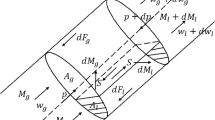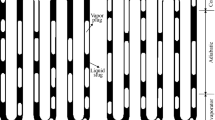Abstract
An experimental study is carried out to study the heat transfer characteristics of a cryogenic oscillating heat pipe (OHP) with long heat transport distance. The OHP is made up of a capillary tube with an inner diameter of 1.0 mm and an outer diameter of 2.0 mm. The working fluid is neon, and the length of the adiabatic section is 480 mm. Tests are performed with the different heat inputs, liquid filling ratios and condenser temperature. For the cryogenic OHP with a liquid filling ratio of 30.7% at the condenser temperature of 28 K, the effective thermal conductivity is 3466–30,854 W/m K, and the maximum transfer power is 35.60 W. With the increment of the heat input, the effective thermal conductivity of the cryogenic OHP increases at the liquid filling ratios of 30.7% and 38.5%, while it first increases and then decreases at the liquid filling ratios of 15.2% and 23.3%. Moreover, the effective thermal conductivity increases with decreasing liquid filling ratio at the small heat input, and the maximum transfer power first increases and then decreases with increasing liquid filling ratio. Finally, it is found that the thermal performance of the cryogenic OHP can be improved by increasing the condenser temperature.










Similar content being viewed by others
Abbreviations
- (dp/dT)sat :
-
Saturation pressure gradient versus temperature (kPaK−1)
- FR :
-
The volumetric liquid filling ratio (%)
- k :
-
The effective thermal conductivity (Wm−1 K−1)
- L :
-
The length between the two centers of the evaporator and the condenser (m)
- P 0 :
-
Pressure of buffer tank before charging with gas (Pa)
- P a :
-
Pressure of buffer tank after charging with gas (Pa)
- Q :
-
The heat input on the evaporator (W)
- R :
-
The gas constant
- R t :
-
Thermal resistance (KW−1)
- S :
-
The summation out cross sectional area of of the capillary tube (m2)
- T c :
-
Temperature of the condenser (K)
- T e :
-
Temperature of the evaporator (K)
- T RM :
-
Room temperature (K)
- V BT :
-
The total volume of the buffer tank and the tube between the buffer tank and the valve V4 (m3)
- V l :
-
The volume occupied by the liquid in the OHP (m3)
- V OHP :
-
The volume of the OHP (m3)
- ρ l :
-
The liquid density (kgm−3)
- ρ v :
-
The vapor density (kgm−3)
References
Faghri A (2012) Review and advances in heat pipe science and technology. J Heat Trans 134(12):123001
Akachi H (1990) Structure of a heat pipe. US Patent 4921041, 1 May, 1990
Akachi H (1993) Structure of micro-heat pipe. US Patent 5219020, 15, June, 1993
Zhang YW, Faghri A (2008) Advances and unsolved issues in pulsating heat pipes. Heat Transf Eng 29(1):20–44
Shao W, Zhang Y (2011) Thermally-induced oscillatory flow and heat transfer in an oscillating heat pipe. J Enhanc Heat Trans 18(3):177–190
Mameli M, Marengo M, Zinna S (2012) Numerical model of a multi-turn closed loop pulsating heat pipe: effects of the local pressure losses due to meanderings. Int J Heat Mass Transf 55(4):1036–1047
Wang W, Cui X, Zhu Y (2016) Heat transfer performance of a pulsating heat pipe charged with acetone-based mixtures. Heat Mass Transf 53(6):1983–1994
Ma HB, Borgmeyer B, Cheng P, Zhang Y (2008) Heat transport capability in an oscillating heat pipe. J Heat Trans 130(8):1325–1329
Yang H, Khandekar S, Groll M (2008) Operational limit of closed loop pulsating heat pipes. Appl Therm Eng 28:49–59
Han H, Cui X, Zhu Y, Sun S (2014) A comparative study of the behavior of working fluids and their properties on the performance of pulsating heat pipes (PHP). Int J Therm Sci 82:138–147
Tseng CY, Yang KS, Chien KH (2014) Jeng MS, et al. Investigation of the performance of pulsating heat pipe subject to uniform/alternating tube diameters, Exp Therm Fluid Sci 54(4):85–92
Jiao AJ, Ma HB, Critser JK (2009) Experimental investigation of cryogenic oscillating heat pipes. Int J Heat Mass Transf 52(15–16):3504–3509
Natsume K, Mito T, Yanagi N et al (2011) Heat transfer performance of cryogenic oscillating heat pipes for effective cooling of superconducting magnets. Cryogenics 51(6):309–314
Mito T, Natsume K, Yanagi N et al (2010) Development of highly effective cooling technology for a superconducting magnet using cryogenic OHP. IEEE Trans Appl Supercond 20(3):2023–2026
Fonseca LD, Miller F, Pfotenhauer J (2015) Design and operation of a cryogenic nitrogen pulsating heat pipe. Adv Cryog Eng IOP Conf Proc 101:012064
Fonseca LD, Miller F, Pfotenhauer J (2014) A helium based pulsating heat pipe for superconducting magnets. Adv Cryog Eng, AIP Conf Proc 1573:28–35
Bonnet F, Gully P, Nikolayev V (2012) Development and test of a cryogenic pulsating heat pipe and a pre-cooling system. Adv Cryog Eng AIP Conf Proc 1434:607–614
Deng HR, Liu YM, Ma RF et al (2015) Experimental investigation on a pulsating heat pipe with hydrogen. Adv Cryog Eng IOP Conf Proc 101:012065
Xu D, Li LF, Liu HM (2016) Experimental investigation on the thermal performance of helium based cryogenic pulsating heat pipe. Exp Thermal Fluid Sci 70:61–68
Li Y, Wang Q, Chen S et al (2014) Experimental investigation of the characteristics of cryogenic oscillating heat pipe. Int J Heat Mass Transf 79:713–719
Liang Q, Li Y, Wang Q (2017) Experimental investigation on the performance of a neon cryogenic oscillating heat pipe. Cryogenics 84:7–12
Huang Y, Chen G (2014) Thermophysical properties of cryogenic fluids. National Defense Industry Press, Beijing
Acknowledgements
This work was supported in part by National Natural Science Foundation of China under Grant 51506192.
Author information
Authors and Affiliations
Corresponding author
Ethics declarations
Conflict of interest
On behalf of all authors, the corresponding authorstates that there is no conflict of interest.
Rights and permissions
About this article
Cite this article
Liang, Q., Li, Y. & Wang, Q. Study on a neon cryogenic oscillating heat pipe with long heat transport distance. Heat Mass Transfer 54, 1721–1727 (2018). https://doi.org/10.1007/s00231-017-2269-z
Received:
Accepted:
Published:
Issue Date:
DOI: https://doi.org/10.1007/s00231-017-2269-z




